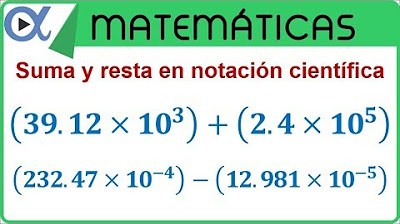Lei de Coulomb - Aula 01 (Teoria e Exemplos)
Summary
TLDRIn this educational video, the professor explains the concept of scientific notation and its applications, including how moving the decimal point affects the exponent and how to convert between forms like '54 x 10^-3' and '5.4 x 10^-2'. The professor also introduces metric prefixes, particularly 'm' for milli, explaining their use in various contexts such as milligrams and milliliters. The video offers useful insights for students preparing for exams like the EA and the Aeronautics Sergeant Exam, with a focus on understanding scientific notation and its real-world relevance.
Takeaways
- 😀 Moving the decimal point in scientific notation adjusts the exponent, making large or small numbers easier to handle.
- 😀 When writing numbers like 54 × 10⁻³ and 5.4 × 10⁻², they are equivalent, demonstrating how shifting the decimal affects the exponent.
- 😀 Understanding how to manipulate the decimal point and exponents is crucial for exams and real-world applications.
- 😀 The professor provides additional resources, such as a video explaining how to move the decimal point and manage exponents.
- 😀 The military entrance exam (e.g., for the Aeronautical Sergeant) often requires knowledge of scientific notation and units like 'm' for milligrams.
- 😀 The prefix 'm' stands for 'milli' (10⁻³) and can be used in various contexts, such as in milligrams (mg), milliliters (mL), or millinewtons (mN).
- 😀 The professor emphasizes that the prefix 'm' is not limited to specific fields like physics; it applies to many areas of study.
- 😀 The content of the lesson is aimed at helping students understand basic scientific concepts that will appear in exams, particularly military-related tests.
- 😀 The professor encourages viewers to engage with the video by liking, subscribing, and sharing it with others who may benefit from the content.
- 😀 Future lessons will dive deeper into more advanced concepts, such as electric force and vector analysis, with a focus on their real-world applications.
Q & A
What is the main concept being explained in this video?
-The video primarily explains how to manipulate scientific notation, focusing on how to move the decimal point (vírgula) and adjust the exponent (expoente). The instructor demonstrates this with examples like 54 x 10^-3 and 5.4 x 10^-2, emphasizing that these are equivalent forms.
What does the instructor mean by 'moving the decimal point'?
-The instructor is referring to shifting the position of the decimal point in a number to convert it into scientific notation. This movement changes the exponent of 10, either increasing or decreasing depending on the direction of the shift.
How can you express the number 54 x 10^-3 in another form?
-You can express 54 x 10^-3 as 5.4 x 10^-2. This is simply done by moving the decimal point one place to the left and adjusting the exponent accordingly.
Why does the instructor use the example '54M'?
-'54M' is used to show how the term 'mil' (meaning thousand) can be written as 10^-3 in scientific notation. It helps illustrate that this conversion is valid in various contexts, such as when measuring forces or quantities in physics or other fields.
What is the significance of 'mil' in this video?
-In this context, 'mil' refers to 'thousand' and can be represented as 10^-3 in scientific notation. The instructor emphasizes that 'mil' is widely used in various contexts, such as 'mil newtons' or '500 mg,' not just in a single specialized area.
What does the instructor mean when they say 'don't think that 'mil' is just for specific areas like Coulomb'?
-The instructor is reminding students not to limit the use of 'mil' (thousand) to a specific context (like Coulomb). Instead, 'mil' can appear in many different contexts, such as when discussing quantities in physics (newtons, coulombs) or in everyday measurements (milligrams, milliliters).
What additional learning resources are provided for students in this video?
-The instructor mentions a separate video that explains how to manipulate the decimal point and adjust exponents in more detail, encouraging students to check it out if they need further help understanding these concepts.
What can students expect in future lessons based on this video?
-In future lessons, the instructor will cover more advanced topics such as vector quantities, including force, which requires understanding not just magnitude, but also direction and sense. These topics will involve higher-level exercises.
Why does the instructor mention 'mil' in the context of medications?
-The mention of 'mil' in the context of medication (e.g., '500 mg') is to show that this term appears frequently in everyday situations, not just in scientific or technical fields. The use of 'mil' is common in dosage measurements and is a practical example for students.
What is the purpose of encouraging students to like and share the video?
-The instructor encourages students to like, subscribe, and share the video as a way to increase engagement with the content. This also helps spread the educational material to others who might benefit from it, growing the community and making the channel more visible.
Outlines

This section is available to paid users only. Please upgrade to access this part.
Upgrade NowMindmap

This section is available to paid users only. Please upgrade to access this part.
Upgrade NowKeywords

This section is available to paid users only. Please upgrade to access this part.
Upgrade NowHighlights

This section is available to paid users only. Please upgrade to access this part.
Upgrade NowTranscripts

This section is available to paid users only. Please upgrade to access this part.
Upgrade NowBrowse More Related Video
5.0 / 5 (0 votes)





